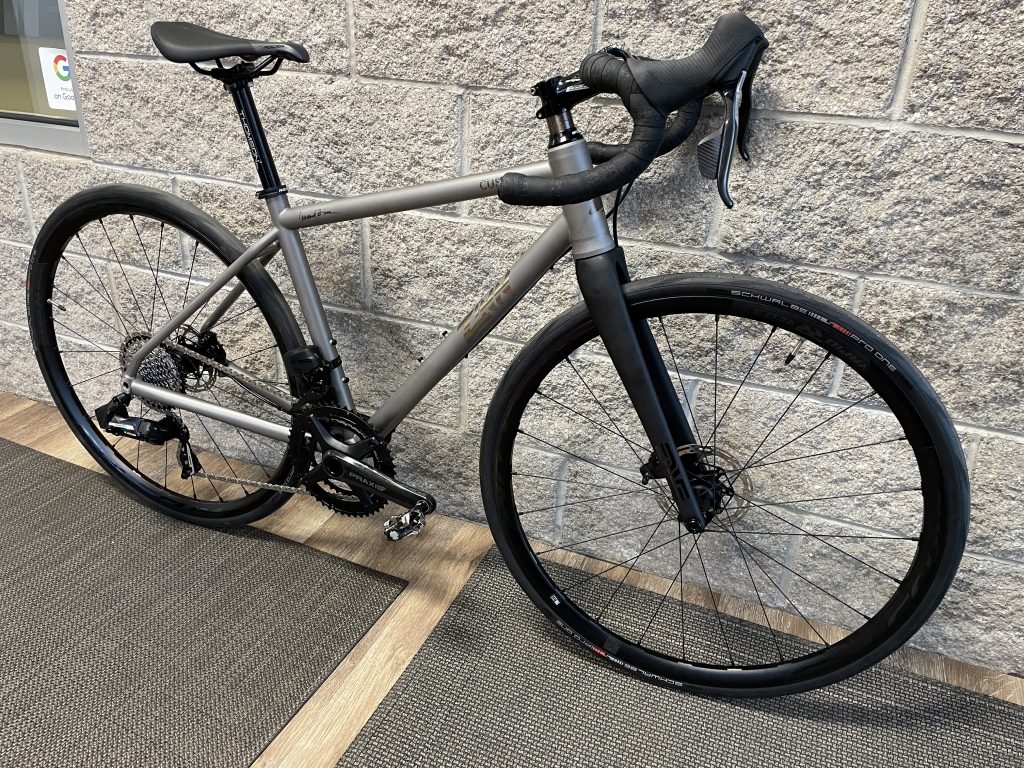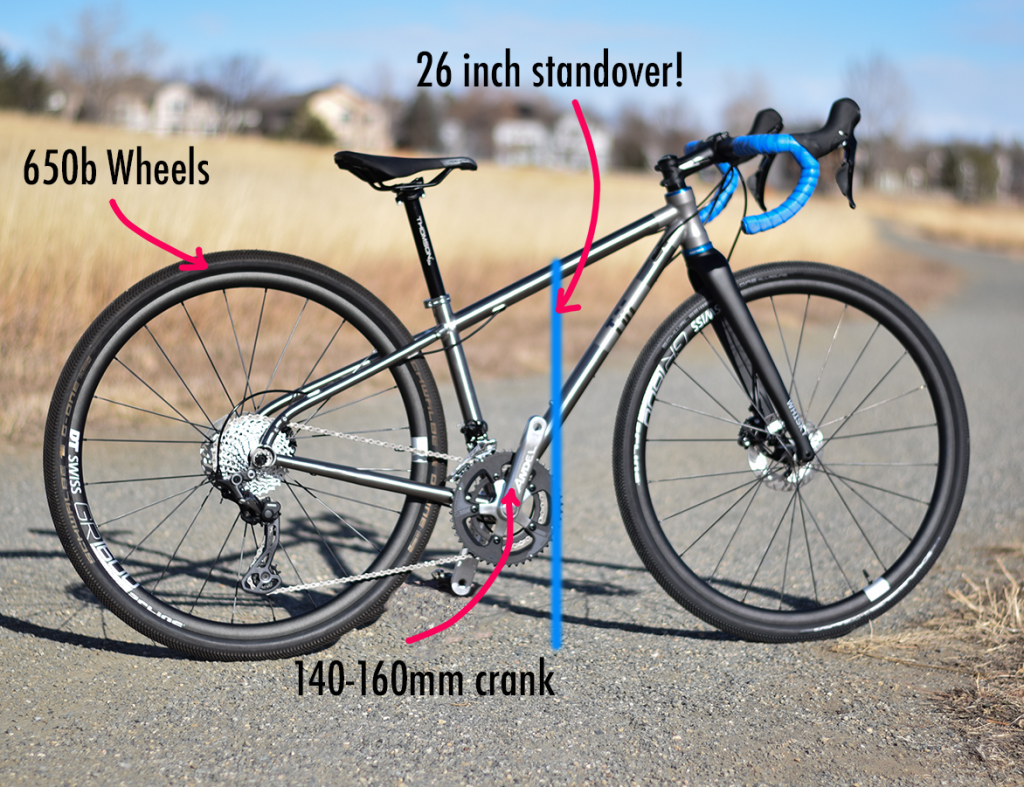By Lennard Zinn
 I built my first bike frame for my wife in 1980, three years before we got married. To calculate its dimensions, I used bike-fitting formulas in a handbook published by C.O.N.I. (Comitato Olimpico Nazionale Italiano), which I understood to be the bible of fitting of the Italian bikes that all riders lusted after in the 1970s and early 1980s. Those calculations resulted in overly long top tubes for small riders (and the opposite for tall riders like me). Watching my wife ride that too-long bike and trying to adapt it with ever-shorter stems drove my quest to discover how to better fit small riders on bikes. From 1984-1991, I co-created and sponsored the Zinn/Alfalfa’s/Shimano women’s (road) cycling team, the first women-only bike-racing team in Colorado. By custom-building bikes for the dozens of riders who came through the team over the years, I learned an enormous amount about how to fit and build fast, comfortable, and efficient bikes for small riders. I built most Zinn custom bikes in the 1980s for small riders, since in those years, big bike brands did not offer good racing bikes in very small sizes, and small riders gravitated to me by virtue of seeing the bikes of the “Zinn team.”
I built my first bike frame for my wife in 1980, three years before we got married. To calculate its dimensions, I used bike-fitting formulas in a handbook published by C.O.N.I. (Comitato Olimpico Nazionale Italiano), which I understood to be the bible of fitting of the Italian bikes that all riders lusted after in the 1970s and early 1980s. Those calculations resulted in overly long top tubes for small riders (and the opposite for tall riders like me). Watching my wife ride that too-long bike and trying to adapt it with ever-shorter stems drove my quest to discover how to better fit small riders on bikes. From 1984-1991, I co-created and sponsored the Zinn/Alfalfa’s/Shimano women’s (road) cycling team, the first women-only bike-racing team in Colorado. By custom-building bikes for the dozens of riders who came through the team over the years, I learned an enormous amount about how to fit and build fast, comfortable, and efficient bikes for small riders. I built most Zinn custom bikes in the 1980s for small riders, since in those years, big bike brands did not offer good racing bikes in very small sizes, and small riders gravitated to me by virtue of seeing the bikes of the “Zinn team.”
If you stand less than 5’5″ tall, you fall outside of the average sized person, so your options for proper fitting bikes diminish the further you are from 5’5″.

Custom Titanium Zinn Bike for 5’2″ rider
Many of the major bike brands claim to offer bikes for small riders and list sizes small, extra small, and even XXS, but when you actually take a minute to look at the geometry, they don’t really work for an extra small person. In our research we have found several brands claiming to have a XXS gravel bike, and when we examine the geometry, the standover clearance is around 29″. They claim that this size fits a 5’0″ person, however, the average inseam length on a 5′ tall person is closer to 27″. The other issue is wheel size, crank length, and handlebar width. Stock bikes typically have stock crank lengths (165mm) , which are suitable for average leg lengths. We have been making custom bikes with shorter (proportional) crank lengths and smaller wheels for decades. Over this time we have seen that there is a demand for an off-the-shelf bike that really fits riders from 4’8″ to 5’5″.
Tui Titanium gravel/road bikes for small riders
When a small rider gets on a Tui titanium gravel/road bike, hardtail mountain bike or e-bike sized to them, they immediately express amazement at how comfortable and natural their body feels pedaling it and how effortlessly and intuitively it handles, giving them a feeling of great confidence when cornering. This is no accident; it is the result of my careful and studied understanding of what the human body in general and a small body in particular requires to be properly supported on a bike for optimal pedaling efficiency, comfort, and control. All of these years of experience have greatly grown my understanding of what it takes to build bikes for small adults.
Some great features of Titanium Bike Frames
- Stiff yet poppy for excellent power transfer
- Ultra compliant for a buttery smooth feel
- Lightweight
- Extremely durable
- Dent resistant
- Can never corrode
- Read more about titanium bikes
A Tui’s strong, springy, high-modulus, 3Al/2.5V titanium tubing, precisely cut and expertly welded together, enhance its lively, efficient feel when climbing, sprinting, descending, and just rolling along. However, titanium only provides part of the magic that makes a small rider feel more at home on a Tui bike than on other small bikes.
Fully Redesigning a bike for the rider
Common issues faced by cyclists under 5’5″
- Pedal/toe overlap
- Insufficient standover clearance
- Inappropriate crank length
- Poor handling performance
Simply scaling a bigger frame down by shortening the top tube, seat tube, and head tube is not the answer to making high-performing, comfortable bikes for small riders. While it might allow the saddle and handlebar to be positioned to fit the rider, this will introduce issues such as pedal toe overlap. In addressing this problem of toe overlap, large manufacturers build the bikes with longer top tubes and shorter stems, which results in very twitchy handling.
Pedal/Toe Overlap solutions
To eliminate toe overlap, small bikes from most manufacturers have steeper seat tubes and shallower head-tube angles than do their mid-size bikes. The steeper seat-tube angle pulls the pedals back away from the front tire, and the slacker head tube angles the fork out ahead, moving the front wheel further from the pedals.
Also to decrease pedal overlap, the top tubes of most small bikes are longer than ideal for the small riders they are targeting, so achieving a comfortable riding position requires the rider to use a very short handlebar stem. As we’ve seen already this means these bikes for small adults will have very twitchy steering characteristics.
What’s wrong with a small bike designed this way?
- First, the short stem combined with the fork angled way out ahead will put the rider’s hands far behind the front tire’s contact patch on the road, resulting in too little of the rider’s weight on the front wheel for good handling.
- Secondly, a super-short stem alone can make any bike feel twitchy, since a small amount of steering input from the rider’s hands will result in a bigger side-to-side rotation of the fork and consequent turning angle of the front wheel than the same amount of hand movement would create with a longer stem. Combining that extra steering sensitivity with the shallow angle of the fork to avoid pedal overlap means that at low speeds, the front wheel will snake back and forth all over the place.
- Finally, the shallow head angle increases “wheel flop,” the amount the fork and front wheel flop over into the turn when the bike is leaned to the side. These effects of high wheel flop, short stem increasing twitchiness, and front wheel way out ahead of the rider will be particularly noticeable when climbing out of the saddle; the bike will weave erratically as the rider pulls on one side of the handlebar and then the other in opposition to the feet pushing on one pedal and then the other.
| Comparing the smallest available gravel bikes from major bike brands
use the bike fit calculator to determine your ideal top tube length |
||||
| Model | Top Tube Length – effective | Effective Seat tube length | Standover height | Crank length |
| Trek Checkpoint | 54.1cm | 49cm | 73.5cm/29″ | 165-170mm |
| Specialized Diverge | 53cm | 49cm | 70cm/27.6″ | 165-170mm |
| Specialized Crux | 51cm | 49cm | 74.9cm/29.5″ | 165-170mm |
| Cannondale Topstone | 53cm | 49cm | 70.4cm/27.7″ | 165-170mm |
| Canyon Grail XXS | 53.3cm | 42cm | 74.5cm/29.3″ | 165-170mm |
| Canyon Grail XS | 55cm | 45cm | 76.6cm/30.2″ | 165-170mm |
| Giant Revolt | 54.3cm | 43cm | 72cm/28.3″ | 165-170mm |
| Tui Titanium XXS | 47.5cm | 42cm | 65.8cm/25.9″ | 140-150mm |
| Tui Titanium XS | 49cm | 46cm | 68.5cm/26.7″ | 155-160mm |
| Tui Titanium S | 52cm | 50cm | 76.2cm/30″ | 160-165mm |
.
Bike Handling
A well designed bike for small people should handle equally well to a bike built for an average sized person. Another deleterious effect of the shallow head angle designed onto most mass produced bikes for small adults is to cause excessive “fork trail,” the amount by which the imaginary intersection of the bike’s steering axis with the road is ahead of the tire’s contact patch on the road. This will make the steering very heavy at speed; the small, lightweight rider will have to work very hard to make such a bike turn quickly when riding fast. Tight switchbacks on a mountain descent will seem arduous to get around; small riders may wonder why taller riders seem to get around them more easily, even though one would think that bigger, longer bikes would be harder to get around tight switchbacks than bikes for small riders, not vice versa.
Crank Length
Bikes for small adults from big brands also come with disproportionately long cranks for short-legged riders. Where riders winning pro road races generally have cranks lengths around 20-21.5% of their inner-leg length, the standard 170mm cranks that come on most small bikes will be 24% of the inner-leg length of a rider with a 28-inch (71cm) inner-leg length, and 26% for a 26-inch (66cm) inner-leg length.
This means that the knees of the short-legged rider will come up disproportionately higher and their relative muscle extension and contraction and knee- and hip-angle ranges required will be greater than those of a rider with longer legs and similar crank length. One negative affect of building a bike for a small rider with long cranks is that the short-legged rider will have to raise their handlebar substantially higher to avoid their thighs hitting their belly or chest. This negates some of the aerodynamic advantage that smaller riders naturally have by being lower in the wind than taller riders. Another is that the tighter hip angles caused by their knees coming up higher will increase tension in their hamstring and low-back muscles, potentially leading to discomfort and low-back pain. Yet another is that their sharper knee bend at the top of the stroke will mean that their quadriceps muscles will be pulling the kneecaps more directly back against the ends of their femurs when pushing down at the top of the pedal stroke, putting greater pressure on the contact between the articular cartilage on the back of the patella (kneecap) and the groove in the femur it slides up and down in during knee flexion. Chronic friction between the patella and this femoral groove can cause a painful condition called patellofemoral pain syndrome and, once the cartilage becomes damaged, chondromalacia patellae. Traditional treatments for this condition in cyclists are to increase saddle height and decrease crank length to reduce knee bend at the top of the stroke.
Cranks that are disproportionately long on bikes for small riders also mandate the steep seat-tube angles of big-brand small bikes to move the rider’s butt forward to get their knee over the forward pedal when their femur is short relative to the crank. This reduces their effective standover crotch clearance, since the steep seat angle positions the nose of the saddle further forward, requiring them to stand further forward where the bike’s up-sloping top tube is higher.
Tui bikes not only come in smaller sizes than those of big brands, but a Tui bike or ebike for short people will also have cranks and wheels that are in better proportion to the rider’s leg length. The XXS, XS, and S Tui gravel/road bikes fit up to 650 X 45B or 700 X 28C tires, rather than the 700 X 42C or 700 X 45C max tire size common on most gravel bikes these days, and they come standard with 140-165mm cranks. The combination of the shorter crank and smaller wheel means that the bike’s “front center” dimension—the distance from the center of the crank to the center of the front hub—doesn’t need to be nearly as long to avoid toe overlap with the front tire when turning as it would with standard 170mm cranks and 700C gravel tires. That allows me to design Tui frames with shorter top tubes than the smallest sizes from the big brands, providing better fit for smaller riders without compromising handling by requiring super-short stems.
And despite having a shallow head angle (to get an even shorter top tube without pedal overlap) the Tui’s smaller wheel size doesn’t have the twitchiness at slow speed and heavy handling at high speed of big-brand small bikes. That’s because the smaller wheel radius means that, while using a fork with a standard amount of rake (offset of the front hub from the steering axis), the fork trail and wheel flop of a very tiny Tui will be like those of a mid-size bike.
A Tui’s shorter crank in better proportion to the rider’s leg length results in a more efficient pedaling style. The knees don’t come up as high, allowing easier breathing without having to raise the handlebars so much, unnecessarily increasing aerodynamic drag. The less-sharp angles at the knee and hip at the top of the stroke with the shorter cranks reduce pressure on the backs of the kneecaps and tension in the hamstrings and low-back muscles. And the smaller wheels and large rear cassettes offer lower gear ratios better adapted to the higher pedaling cadence that shorter cranks encourage.
The shorter crank in more standard proportion to the rider’s leg length also means that the knee can be over the forward pedal with a standard seat-tube angle rather than requiring the steep seat angles of big-brand small bikes incorporating too-long cranks. This also gives the rider more standover clearance since the saddle is not pushing them so far forward over the higher part of the top tube when standing over it. Plus, Tui bikes have lower standover height (measured from the ground to the top of the top tube at the center of its length) anyway than big-brand bikes aimed at a similar-sized rider.
Making a bike proportional to the rider’s size
It makes sense to everyone that every part of a small child’s bike is proportionately smaller than on a big bike, but this understanding seems to go out the window with bikes for small adults as well as tall adults. Any parent sees the sense of the small wheels and short bicycle cranks on their kids’ first bikes and how the wheels and cranks are bigger on their next bikes as they grow. But despite the enormous difference in sizes between adult humans, wheels on adult road bikes are always 700C and cranks on adult bikes are in a narrow 165-175mm range. Not on a Tui bike, though! Everything about a Tui bike is proportional to the rider. The frame, wheels, and cranks are appropriately sized to the rider, and the saddle and handlebar widths are based on the rider’s sit-bone and shoulder widths.
I love having the opportunity with our Tui brand to offer bikes for small riders that fit great and perform extremely well. Their wide grins when first pedaling them make it all worth it.






